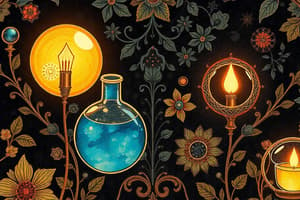Podcast
Questions and Answers
What type of bonding is typically found in non-metals?
What type of bonding is typically found in non-metals?
- Hydrogen bonds
- Ionic bonds
- Covalent bonds (correct)
- Metallic bonds
Which property is commonly observed in metals when freshly polished?
Which property is commonly observed in metals when freshly polished?
- Non-luster (correct)
- Poor conductivity
- Low density
- Non-metallic color
Which state do non-metals commonly exist in at room temperature?
Which state do non-metals commonly exist in at room temperature?
- Solid
- Gas (correct)
- Liquid
- Plasma
What is a key difference between metals and non-metals in terms of reactivity?
What is a key difference between metals and non-metals in terms of reactivity?
Which of the following is a common non-metal that does not have a metallic color when freshly exposed?
Which of the following is a common non-metal that does not have a metallic color when freshly exposed?
Which property allows metals to be easily shaped and molded through processes like hammering and rolling?
Which property allows metals to be easily shaped and molded through processes like hammering and rolling?
What property of metals makes them excellent conductors of heat, electricity, and sometimes sound?
What property of metals makes them excellent conductors of heat, electricity, and sometimes sound?
Which characteristic of metals contributes to their shiny appearance?
Which characteristic of metals contributes to their shiny appearance?
In terms of state at room temperature, how do metals generally compare to non-metals?
In terms of state at room temperature, how do metals generally compare to non-metals?
Which unique type of bonding do metals possess in which positive metal ions are surrounded by a 'sea' of electrons?
Which unique type of bonding do metals possess in which positive metal ions are surrounded by a 'sea' of electrons?
Flashcards are hidden until you start studying
Study Notes
Metals and Non-metals: Exploring their Distinct Properties
Metals and non-metals are two primary categories of elements that you'll encounter in chemistry. Each group has unique properties that set them apart and inform their uses in various applications. Let's delve into the fascinating world of metals and non-metals, exploring the characteristics that define them.
Metals
Metals are a group of elements that share several common properties:
-
Malleability and ductility: Metals are easily shaped and molded through processes such as hammering, rolling, and forging, which is due to their ability to slide past one another without breaking.
-
Conductivity: Metals are excellent conductors of heat, electricity, and sometimes even sound. This property makes them indispensable in manufacturing electrical components and appliances.
-
Luster: Metals have a shiny appearance, which results from their reflective surface.
-
Metallic bonding: Metals have a special type of bonding in which positive metal ions are surrounded by a "sea" of electrons.
-
High density: Compared to non-metals, metals are generally denser.
-
Reactivity: Metals are typically more reactive than non-metals, which means they tend to lose electrons in chemical reactions.
-
Solid at room temperature: Most metals are solid at room temperature and maintain their shape unless heated or stressed.
-
Metallic color: Metals often have a metallic color when freshly polished, such as silver, gold, and copper.
Some common metals include aluminum, iron, copper, gold, and silver.
Non-metals
Non-metals, on the other hand, have their own unique properties:
-
Poor conductivity: Non-metals are poor conductors of heat, electricity, and sound.
-
Non-metallic bonding: Non-metals typically have covalent or ionic bonds, which involve the sharing of electrons or the transfer of electrons from one atom to another.
-
Low density: Non-metals are less dense than metals.
-
Non-luster: Non-metals do not have a shiny appearance and lack reflectivity.
-
Low reactivity: Non-metals are generally less reactive than metals.
-
Gases, liquids, or solids at room temperature: Non-metals exist in different states at room temperature, such as gases, liquids, or solids.
-
Non-metallic color: Non-metals do not have a specific color when freshly exposed, but they may appear in various colors when combined with other elements or in different forms.
Some common non-metals include carbon (graphite and diamond), nitrogen, oxygen, hydrogen, and chlorine.
Applications
Metals and non-metals have their unique applications due to their properties:
Metals:
- Electrical components and appliances
- Building materials
- Transportation
- Art and jewelry
Non-metals:
- Gases for inflation, cooling, and fuel
- Lubricants and plastics
- Fertilizers and pesticides
- Cooking and cleaning
Understanding the properties of metals and non-metals is essential for developing new materials and technologies, and it's the fundamental basis for many scientific discoveries. The next time you encounter a shiny coin, a sparkling gemstone, or a fluffy pillow, you'll have an appreciation for the fascinating world of metals and non-metals.
Studying That Suits You
Use AI to generate personalized quizzes and flashcards to suit your learning preferences.




